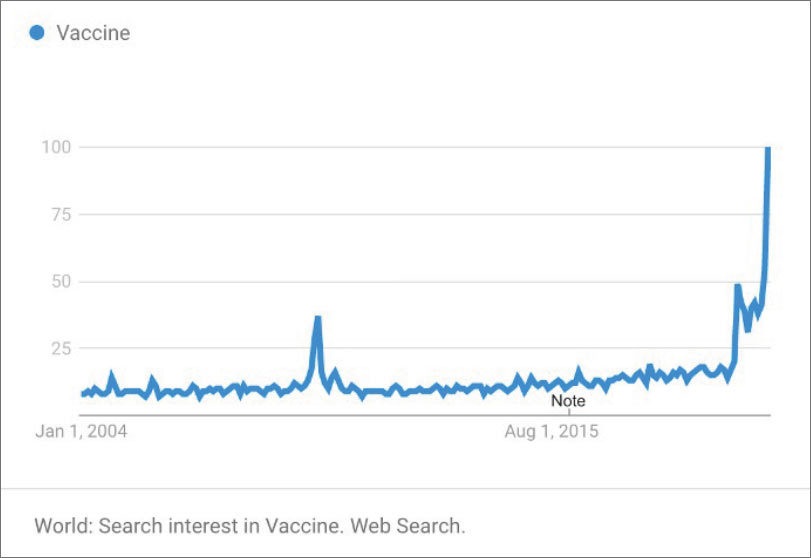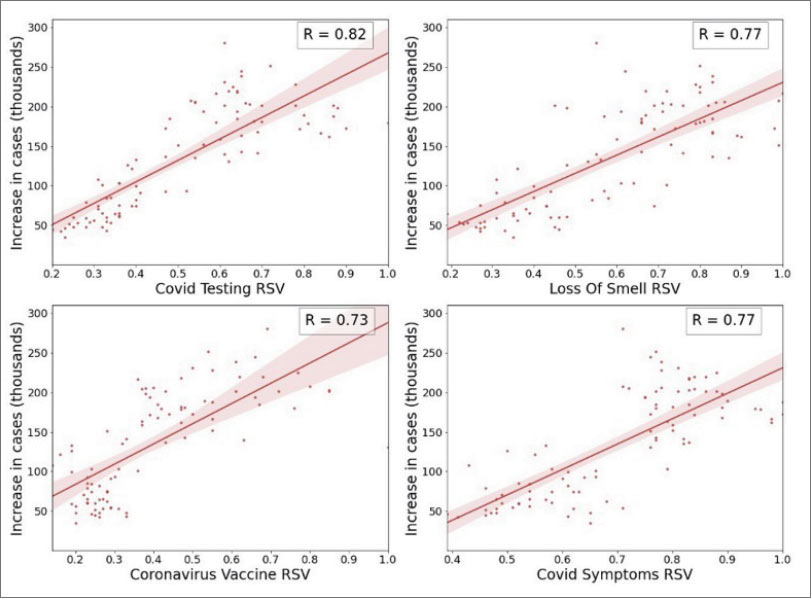This post is the last in our three-part series examining COVID-19’s effect on healthcare. The content was derived from our recent webinar collaboration with Modern Healthcare, COVID’s Call to Action: Resetting for Success in 2021. Part one discussed how to improve patient access and loyalty. Part two talked about how healthcare executives can better support clinicians. Here, we look at how consumer interests and behavior has changed over time during the course of the pandemic.
If we go back to what the world was feeling when COVID-19 began its march across the country a year ago, we find more uncertainty than knowns, and most of us had no way of anticipating what we would be up against at that time. Our patients and communities were desperate for information and trying to find the best way to manage on all key fronts.
Consumer Search Trends
Google Trends shows how COVID-related search terms trended starting in March of 2020, reaching their peak on March 12 when numbers of infected patients began increasing and COVID-19 was declared a pandemic.
As awareness grew, people asked about topics involving COVID-19 symptoms, quarantine, testing, and vaccines. Today, it’s not entirely surprising that COVID vaccine-related searches now outrank all others.

Growth in search volume for “vaccine” according to Google Trends.

Questions people are asking about the COVID-19 vaccine.

The chart above shows Google Trend results for five words (the maximum number allowed for comparison): Coronavirus, Corona, Virus, Covid, and Covid-19.
Coronavirus-related searches constituted three of the top five Google searches in 2020 in the United States, the Harvard College Open Data Project (HOPD) reports. They also topped the list for global searches and news, a trend that will likely continue until the pandemic ends.
HOPD researchers looked at various COVID-related keywords and their search trends and found “strong correlations” existed between keyword popularity and daily new COVID-19 cases in the U.S. They discovered that people were most interested in four distinct keywords and topics—covid symptoms, loss of smell, coronavirus vaccine, and covid testing.

Today, COVID-19 searches still dominate, exceeding inquiries about non-COVID-related news, weather, politics, and other perennially popular topics. In response, Google released the Google Trends Coronavirus Hub to track emerging searches.
Consumer Interests and Behavior
Let’s transition from looking at keyword trends to consumer behavior changes that resulted from the pandemic, particularly those associated with healthcare.
Growing Optimism
There is growing, although guarded optimism among consumers. People are starting to venture out of their homes, and the economy is beginning to rebound. Some states have lifted COVID-related restrictions, such as wearing masks and limiting gatherings.
“While economic optimism recovered steadily from late spring to early autumn, since October, about 40 percent of U.S. consumers are consistently optimistic, while just under 15 percent remain pessimistic,” states a McKinsey report.
Vaccinations Accelerating Recovery
When comparing those who have been vaccinated to those who say they are likely to get vaccinated, McKinsey found vaccination drives more out-of-home activity (33 percent engaging out of home versus 22 percent among those who intend to be vaccinated) and promotes higher spend intent for out-of-home activities, such as eating out, out-of-home entertainment, and travel.
Telehealth Use
A PWC Health Research Institute (HRI) survey revealed new telehealth users include generally healthy people looking for a quick visit and people with more complex medical conditions who need to manage their health.
The survey also found that five percent of American consumers reported they or a family member used telehealth for the first time during the pandemic, and eighty-eight percent would use it again.
Health Monitoring on the Rise
Deloitte reports that more consumers are using technology to monitor their health, measure fitness, and order prescription-drug refills. Also, consumers are more comfortable sharing data than before the emergence of the virus.
Increased Health Awareness
COVID-19’s spread caused consumers to become more conscious of their health and wellbeing. A consumer survey from August 2020 said that respondents cited “personal health” and “health of friends and family” as their most important concerns. This emphasis on improved health is finding expression in two specific areas:
- Focus on Fitness. More people are focusing on fitness and using digital technology in the form of fitness apps to do so. It was forecasted that fitness app use would increase by 25 percent to 826 million users in 2020, and to one billion users by 2024.
- ·Better Nutrition. The need to build immunity is causing consumers to pay closer attention to their nutrition and healthier eating habits. Also, demand for immunity-boosting supplements is expected to continue even after the pandemic.
Mental Health Importance
Mental health has grown in importance as many people have been affected by the stress of contracting COVID-19 and changes to daily lives, such as restricted movements, working from home, and fear of job loss. Demand for mental wellness services has also gone up in response to increased awareness and recognition of mental wellbeing.
More Active Health System Role
The HRI survey also found that American consumers are taking on a more active role in the health system. It says that, for example, many people are willing to participate in clinical trials or share their personal data to help discover new treatments or ways of delivering care.
As encouraging as these findings are, not all the news is positive. Reports revealed two particular areas with identifiable opportunities for hospitals and health systems:
Challenges with Social Determinants of Health
Americans reported more difficulties with social determinants of health during the pandemic.
Fifty-three percent of consumers said that before the COVID-19 outbreak, at least one social or environmental factor—such as sleep, affordable housing, or childcare—affected their ability to adopt a healthy lifestyle. During the pandemic, sixty-one percent reported to HRI that they are affected by at least one of these social determinants of health
Pandemic’s Impact Varies by Race and Ethnicity
This virus is exacerbating the longstanding issue of racial disparities in health and wellbeing. Deloitte says that Blacks and Latinos have been “disproportionately affected by COVID-19 in a widespread manner” across geographic regions and age groups. This means as our industry prepares for a future beyond COVID, there needs to be a strong focus on how the pandemic has changed consumers’ feelings, behaviors, and interactions with their healthcare providers.
Conclusion
The COVID-19 pandemic has turned the healthcare system upside down and endangered consumers’ sense of wellbeing. But positive outcomes have also resulted from the chaos.
The public health crisis caused by the pandemic has pushed the healthcare industry to provide consumers with access to care from home and encouraged them to have greater agency in making decisions about their health.
As a result, consumers are taking charge of their health more than ever before. They are learning about health risks, using technology to communicate with healthcare professionals in new ways, and changing their attitudes about data privacy. As the crisis’s impact begins to wane, there is every reason to believe consumers will continue down that path.
Related Resources:
- Webinar: COVID’s Call to Action
- Tip Sheet: ‘Must Take’ Steps to Thrive Amidst Chaos
- Resource: Healthcare Landscape in COVID-19 Times: Regaining Patient Trust


